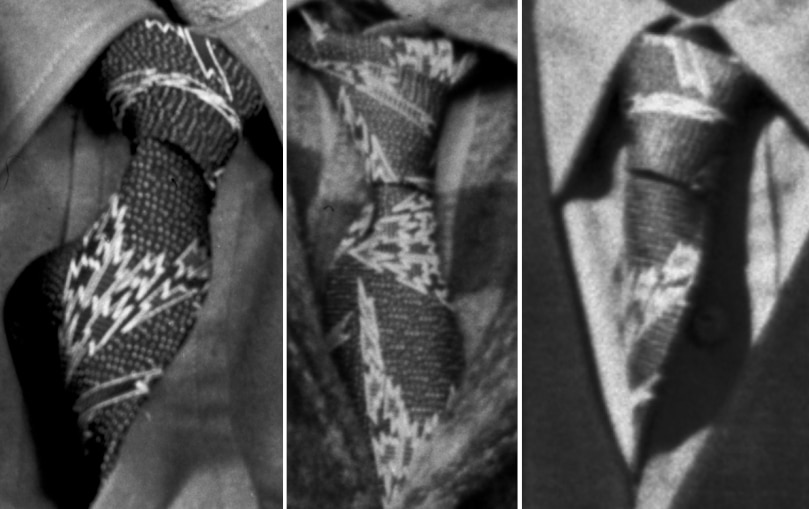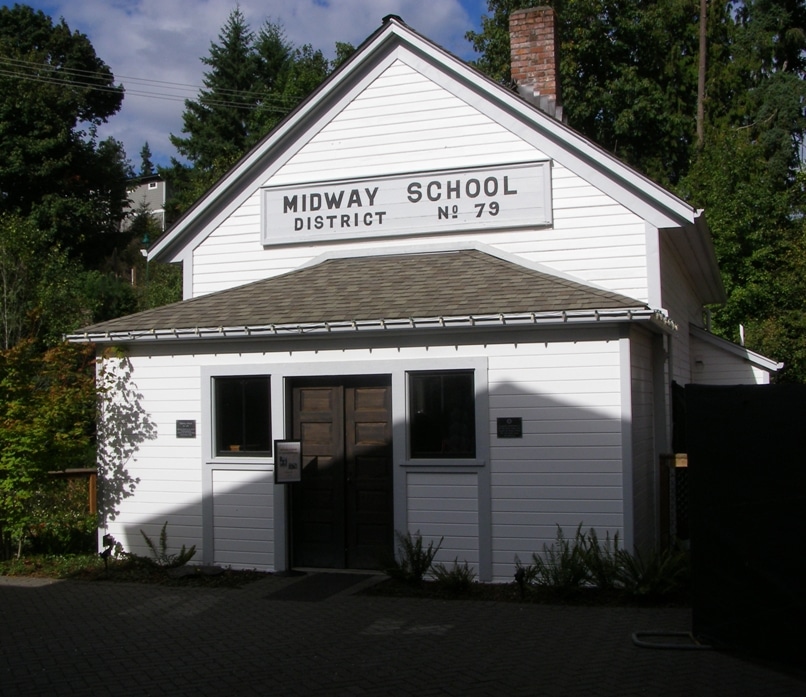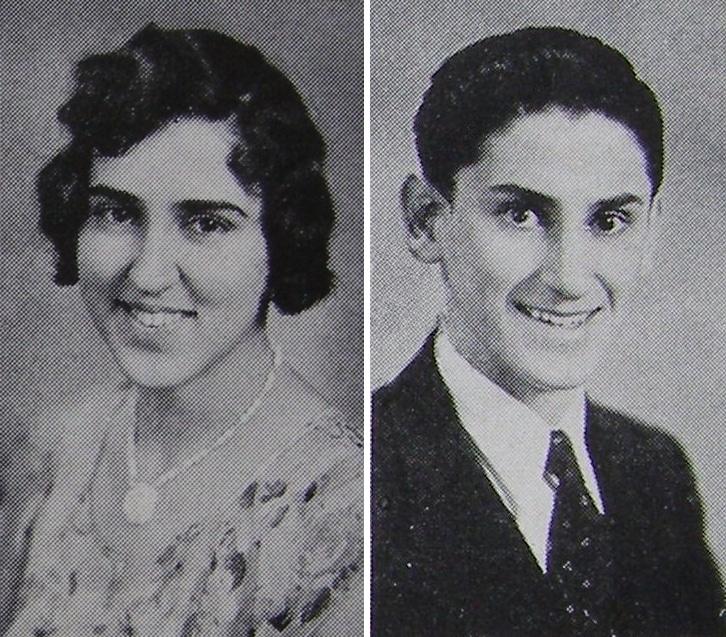Arts & Entertainment Community
Gig Harbor Now and Then: Harassment and bullying were behind this Midway School riddle
Partial digression resolution
This week we’re starting off with our previous digression, where we asked two questions to which we did not have the answers. We have one now.
Arts & Entertainment Sponsor
Arts & Entertainment stories are made possible in part by the Gig Harbor Film Festival, a proud sponsor of Gig Harbor Now.
It’s nice and appreciated that Lynn Kennard, a daughter of Proctor Peacock, took the time to confirm that the Harbor History Museum photo we linked to last time is indeed misidentified, and is not of her father. Thank you, Lynn.
For that photo, it’s one question down, one to go. Now we know with certainty who it isn’t. We’d like to know who it is.
Once again, this is the photograph in question, taken in 1942 by Frank Shaw.
My guess as to who it might be — and it’s just a guess — is Irwin Rust. He owned The Tinker Shop in the north end business district of Gig Harbor and was married to Lillian, one of the Goodman sisters.
This is a picture of Lillian and Irwin Rust, taken three months before the photograph in question.
This is a picture of them taken in 1946.
Here’s another picture of Irwin Rust, taken the same day, but without his hat.
Being a terrible judge of faces, my guess is based mostly on the necktie. Doesn’t it look like Irwin Rust and the unidentified man are wearing the same tie?

The unidentified man’s necktie is on the left. The center and right ties are worn by Irwin Rust in other photos. All three tightly cropped tie pictures are from the collection of the Harbor History Museum. While I’m not allowed to use complete photographs from the Museum, I’m hoping I didn’t sign any sort of affidavit, agreement, or memorandum of understanding without a tightly-cropped necktie exceptions clause, or I might be in big trouble.
And, as Linda McCowen pointed out earlier in the week, in one photo Irwin Rust is wearing his tie the same way as the unidentified man, tucked into his shirt above a high button. His reason may differ, but from personal experience I can testify that it’s an effective way to hide a massive gravy stain.
An identically patterned tie is hardly enough to base a positive identification on, of course. But if it adds enough evidence to turn a mild speculation into a reasonable one, the new caption can at least say something along the order of, “This might be Irwin Rust.”
Readers’ opinions are welcomed.
Future photo ID questions
A great follow-on question would be: What did Irwin Rust spill on his tie?
OK, so maybe it’s not so great. We’d never find the right answer, so we’ll have to skip it. Besides, maybe he didn’t spill anything on it. Maybe he got it caught in a piece of machinery and the bottom half was torn off. We just don’t know.
Today’s question will not be the last appeal to Gig Harbor Now and Then readers for help in identifying people and places in Harbor History Museum photographs. The next one won’t be posted this week, but it’s already been selected. Quite unintentionally, it happens to be another one concerning the (extended) Peacock family. It shows a niece of Proctor, if I’m not mistaken, and one other young woman.
A Midway School riddle
Returning now to something we do know the answer to, the last question asked in this column was kind of a riddle. In the late 1910s, Lola Spadoni started her formal education at Midway School two years before her younger brother Julius. Lola did not flunk any grades, and Julius didn’t skip any grades. Yet they were both in the same graduating class at Gig Harbor Union High School.
Question: Why were Lola and Julius Spadoni in the same graduating class?
Answer: Because their mother took Lola out of Midway School for two years due to intense and relentless bullying by some of the other students.

Not all memories of Midway School are good ones. Photo by Greg Spadoni.
Not Mr. Rogers’ neighborhood
Lola developed such anxiety over going to school, having to face mean-spirited harassment every day, that she would get physically sick and throw up while walking the mile and three quarters on dirt roads between Shore Acres and Midway, unable to continue. Her mother eventually pulled her out of school one year, and held her out the next, for it became pointless for her to set off for school and not arrive.
When Lola did go back to school with Julius two years later, the bullying didn’t stop. Being small for his age, he faced it too.
They were targets of harassment simply for being of Italian descent, which caused them to tan quickly and darkly in the summer, and, because of having been raised in an Italian-speaking household, they spoke funny. That they weren’t exactly like the other students in the one-room school — all of Norwegian, Swedish or Danish descent — was simply too much for some of the light-skinned Scandinavian kids to tolerate.
The troublemakers found great sport in taunting the “dirty little Italians,” picking on them relentlessly. When picked on by a group, the two small Spadoni kids would stand back-to-back to better defend themselves from the circling predators.
On one occasion Julius was forced to defend himself from physical attack by a classmate who tried to stab him with a pocket knife, just because he wasn’t Scandinavian.
(I recall hearing Julius tell the story twice, and if I could remember who his assailant was, I’d print his name here, but I do not. Of their tormentors in general, Lola once mentioned that Donald Nelson was particularly mean to them. In somewhat of a coincidence, as adults, Lola, Julius, and Donald Nelson all raised their families in Rosedale, on opposite sides of a small lagoon.)
More commonly, the attacks were at least somewhat less violent – taunting, pushing, knocking them down, tearing their school papers, and even ripping their clothes. But it was the knife attack that brought the problem to a head, at least in the slightest possible meaning of the phrase.
A poor solution
Lola and Julius’ mother, Anita Spadoni, went to the school and demanded that something be done to stop the relentless and sometimes violent harassment of her two children. Whether she spoke only to the teacher or also to the three school board members is not known. Whoever it was, they did manage to come to a solution of sorts. It was a ridiculously stupid solution, but they put it into practice anyway. Instead of addressing the behavior of the problem students, they placed the burden entirely on the Spadoni kids.
In what reads like the punch line to an unfunny joke, the Midway School teacher, as the solution to the bullying, started dismissing Lola and Julius from school 15 minutes earlier than the other students, giving them time to run towards home as fast as they could. In both theory and in practice, that gave them a head start on the prejudiced delinquents who found beating up on little kids to be a fair and noble sport.
In later life, Lola recalled that when dismissed early, they would run towards Simpson’s Corner (where the Gig Harbor campus of Tacoma Community College now stands) at full speed, and only when they got there and turned east on Hunt Road did they feel safe enough to slow down.

To escape the bullies who hounded them regularly, when leaving Midway School Lola and Julius Spadoni would run as fast as they could towards home. Only when they reached Simpson’s Corner and turned east on Hunt Road did they feel safe enough to slow down. It was three-quarters of a mile to Simpson’s Corner. Pierce County Assessor-Treasurer aerial base map.
In the first decades of non-native settlement, the Gig Harbor Peninsula was not the harmonious melting pot of cultures, traditions, and nationalities many people would like to believe. It would largely become that later, during the rearing of the baby-boom generation, who experienced no such discrimination. But it had broad areas of cultural segregation until about the 1940s.
Had all the Spadoni kids been given the opportunity to attend Lincoln School with the Slavonians, like their middle sister Clara had managed to do, they would’ve blended in with the other students. But they were in the Midway District, so were ostracized and picked on by some of their classmates for not being Northern European. Never mind that they were Americans, just like the other students. Never mind they were innocent children. Never mind they were smaller than most of their classmates. They spoke funny for a couple years, and forever tanned a shade or two darker than the pale Scandinavians. Those kinds of trivial things simply could not be tolerated on certain parts of the pre-WW2 Gig Harbor Peninsula.
A real solution
So, how did it all turn out? Well, several things happened that seemed to change the behaviors, if not the minds, of even the most brazen bullies. A couple years after Julius started school at Midway, his brother Roy entered the first grade there. Roy was always big for his age. He was also very friendly and likeable. By the time he started school, his English was far better than his older siblings’ had been when they first attended. There are no family stories of Roy being bullied. And around the time that Roy started school, or a little later, the rest of the Spadoni kids were speaking English every bit as well as the other students.

Siblings Lola and Julius Spadoni overcame intense bullying during their early years at Midway School to excel in academics and athletics in high school. These photographs are from the 1932 Union High School year book, accessed at the Harbor History Museum.
After the bullying stopped, Lola thrived, regularly making the honor roll in high school. She was both the president and valedictorian of the Union High School class of 1932.
Julius had a growth spurt as a teenager, shooting up to 6-foot-1, and became very athletic. He wasn’t bullied anymore. He was actually befriended by his attacker who had wielded the pocket knife as a weapon, years before. Apparently, even bullies have survival instincts.
Fighting fire with … something
From triumph over bullies, we now turn to triumph over fire. Sort of.
In 1923, the center of Gig Harbor’s business activity was at the north end of the bay, where today’s Finholm district is located. Several commercial buildings fronted both sides of the street.
In May of that year, a fire completely destroyed four buildings on the water side of the road, but all the structures on the opposite side were saved by a random variety of local volunteers. Employing every piece of firefighting equipment purchased during an ultimately failed attempt to form a local fire department about eighteen months prior, they managed to prevent the fire from leaping across the street. As an unorganized group, the local firefighters were not equipped as well as a professional force or an established volunteer department, but they were not without firefighting equipment.
What firefighting equipment did the unorganized Gig Harbor volunteers have in May 1923?
Hint: as much as I like the visual it conjures, it wasn’t an arsenal of squirt guns.
We’ll have the answer on Jan. 29. We’ll also introduce the story of a very strange and unique occurrence on the Key Peninsula during World War Two.
Where have the ugly chapters of history gone?
The intense ethnic discrimination against two of the Spadoni kids at Midway School over a hundred years ago is a very disturbing chapter of local history. Why have such stories been virtually forgotten? Can it be simply because they’re too unpleasant to recall? Or could the real reason be that in later years, those who experienced them were too busy getting on with their lives to spend much time looking backward?
Good times and bad times all play a part in shaping the future. A thorough understanding of how neighborhoods, towns, and societies came to be the way they are today can’t be reached without all influences being considered.
Are there unpleasant aspects to the Gig Harbor and Key peninsulas’ history you’re aware of that should be given more consideration? What’s been overlooked for too long? How has uncomfortable history shaped the peninsulas since the 1860s?
While ethnic discrimination on the Peninsula seemed to burn itself out in the 1940s, did it make a comeback in later generations?
No matter the rises and falls of various forms of discrimination, bullying in general never went away. It’s still going on today. How well would the Midway School’s answer to the problem 100 years ago be received in our current society?
At the end of every Gig Harbor Now and Then column we have been inviting readers to post comments or answers to questions of local history on the Gig Harbor Now Facebook page. It’s mostly in fun, but this is an opportunity to participate in a serious discussion on a serious topic.
What unpleasant events or circumstances are missing from the local historical record?
Greg Spadoni of Olalla has had more access to local history than most life-long residents. During 25 years in road construction working for the Spadoni Brothers, his first cousins, twice removed, he traveled to every corner of the Gig Harbor and Key Peninsulas, taking note of many abandoned buildings, overgrown farms, and roads that no longer had a destination. Through his current association with the Harbor History Museum in Gig Harbor as the unofficial Chief (and only) Assistant to Linda McCowen, the Museum’s primary photo archive volunteer, he regularly studies the area’s largest collection of visual history. Combined with the print history available at the Museum and online, he has uncovered countless stories of long-forgotten local people and events.

